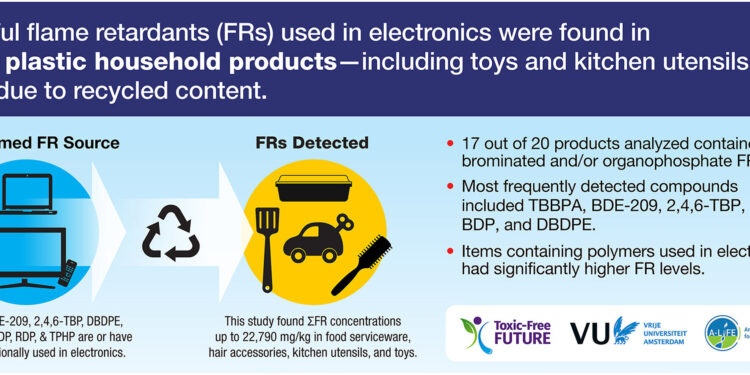Graphical summary. Credit: Chemosphere (2024). DOI: 10.1016/j.chemosphere.2024.143319
From toys to kitchen utensils to takeout trays, researchers have discovered a toxic chemical banned in many common household items due to its link to cancer. Exposure to flame retardant can cause serious health risks.
“We knew before we even started this study that there was no reason for our food contact items, cooking utensils or toys to contain harmful flame retardants,” explained the lead author of study, Megan Liu, in her report.
“As I do what I can to replace my household items with safer alternatives, I hope that studies like this, along with the ever-growing body of research proving just how dangerous plastics are, will help to push our governments and retailers to act now. and switch to safer materials.
Published in the journal ChemosphereLiu and his fellow researchers discovered nine toxic flame retardants in household items containing black plastic. Some items had high concentrations of chemicals, up to 2.3% by weight.
In 70% of the samples tested, they found traces of deca-BDE, a retardant banned by the Environmental Protection Agency in 2021. But new retardants were also found, including a recently detected hormone-disrupting chemical in human breast milk.
According to Liu, chief science and policy officer at the environmental advocacy group Toxic-Free Future, dangerous chemicals are likely ending up in household items due to poor recycling practices.
“We know that some electronics companies include very dangerous flame retardants in their products and believe it is very likely that some of this flame-retardant plastic is recycled and ends up in household items like toys and utensils cooking,” she said. “And this is what we found: Flame retardants linked to cancer and hormonal disruptions are found in the products that we use to eat or prepare food, or that our children play with.”
The most common flame retardants, PBDEs, can disrupt brain development in children and have been linked to increased risks of cancer. Bromophenols, alternatives to PBDEs, can affect fetal development and have been detected in the placenta and breast milk.
Liu gave some tips on how to avoid contamination: Avoid black plastics where food and children are involved.
“Since receiving the results of this study, I have replaced all of my black plastic cooking utensils with plastic-free wooden or stainless steel utensils,” she wrote. “And I opted for reusable glass containers instead of saving and reusing my black plastic takeout containers.”
More information:
Megan Liu et al, From e-waste to the living space: Flame retardants contaminating household items add to concerns about plastic recycling, Chemosphere (2024). DOI: 10.1016/j.chemosphere.2024.143319
2024 The Atlanta Journal-Constitution. Distributed by Tribune Content Agency, LLC.
Quote: From kitchen utensils to toys to household items linked to toxic flame retardants (October 3, 2024) retrieved October 3, 2024 from
This document is subject to copyright. Except for fair use for private study or research purposes, no part may be reproduced without written permission. The content is provided for informational purposes only.



